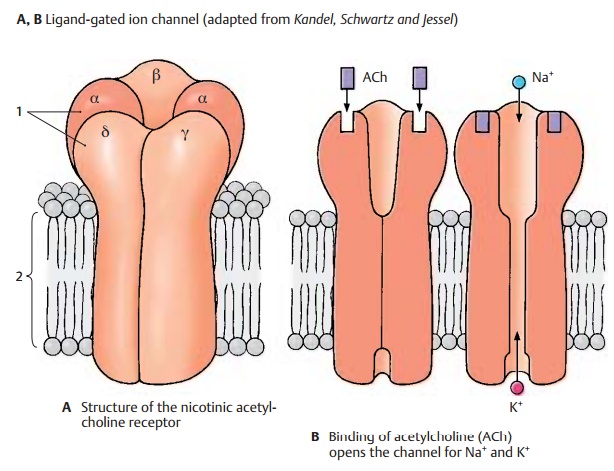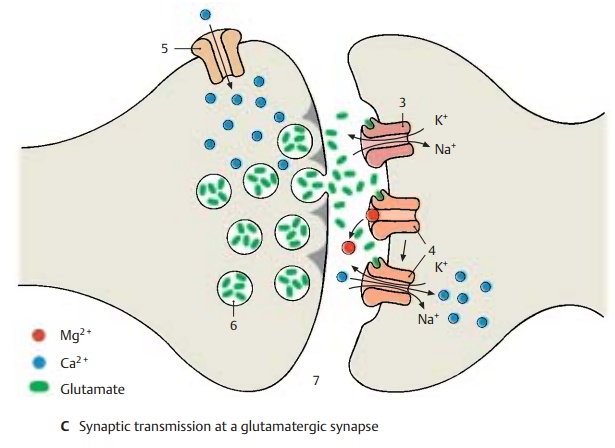Chapter: Human Nervous System and Sensory Organs : Basic Elements of the Nervous System
Transmitter Receptors - The Synapse

Transmitter Receptors
There are two categories of neurotransmitter receptors: ligand-gated ion channels and transmitter receptors coupled to an intra-cellular guanosine triphosphate-(GTP-) binding protein (G protein).
Ligand-gated Ion Channels
Ligand-gated ion channels consist of differ-ent subunits (A1) that are inserted into the cell membrane (A2). Binding of the neu-rotransmitter to the specific receptor causes the channel to become permeable to certain ions (B).

Excitatory amino acid receptors.Recep-tors for the excitatory transmitter glutamate are classified according to the synthetic li-gands binding to them. There are three types of glutamate-gated ion channels: the AMPA (aminohydroxymethylisoxazole-propionic acid) receptor (C3), the NMDA (N-methyl-D-aspartate) receptor (C4), and the kainate receptor. Binding to the AMPA re-ceptor causes an influx of sodium ions, thus leading to depolarization of the cell. Simi-larly, activation of the NMDA receptor causes an influx of both Na+ and Ca2 +. Under conditions of resting potential, the NMDA receptor is blocked by magnesium; the magnesium blockade is lifted by depolariza-tion (through AMPA receptors). This tem-poral shift in activities of the AMPA and NMDA receptors results in a graduated re-sponse of the postsynaptic neurons to the neurotransmitter glutamate.

Inhibitory GABA and glycine receptors. GABA is the most common inhibitory trans-mitter in the brain, and glycine in the spinal cord. Both receptors are ligand-gated ion channels that cause the influx of chloride ions when activated. The cell thus becomes hyperpolarized and inhibited.
Ligand-gated ion channels include the exci-tatory, cation-permeable nicotinic acetyl-choline receptor and the serotonin (5-HT) re-ceptor.
Receptors Coupled to G Protein
Most neurotransmitters do not bind to lig-and-gated channels but to receptors coupled to G protein. The main difference between the two types of receptors is in the speed of the synaptic response. In the case ofligand-gated ion channels, the activation causes a rapid synaptic potential lasting only for milliseconds. Activation of G pro-tein-coupled receptors results in responses that last seconds or minutes. G proteins regulate enzymes that produce intracellular messenger substances. These have an effect on ion channels or, via regulatory proteins, on the expression of genes.
Related Topics